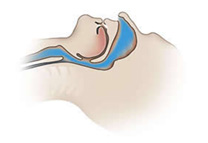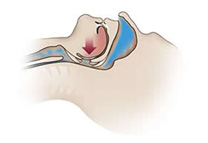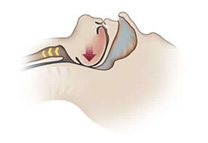
OVERVIEW:
Obstructive Sleep Apnea (OSA) is a potentially life-threatening disorder that causes a person to stop breathing during sleep. It is a disease spectrum that varies in severity and treatment, and tends to worsen as a person ages or gains weight.
CAUSES:
Snoring and Upper Airway Resistance Syndrome (UARS) occur when the airway is restricted. The snoring sound is produced when air passes over the soft tissues in the throat causing them to vibrate. Approximately half of loud snorers also suffer from sleep apnea.
Obstructive sleep apnea (OSA) occurs when the muscles in the throat relax, allowing the tongue to fall back into the airway, blocking the flow of air. This reduces the amount of oxygen that is delivered to the body's organs, including the heart and brain.
Each pause in breathing, or apnea, lasts from 10 seconds to over a minute in length and may occur hundreds of times in a single night. These pauses in breathing deprive the brain of oxygen and cause strain on the heart as the body needs to jolt the sleeper awake each time in order to resume breathing. In spite of the repeated arousals experienced by people who suffer from sleep apnea, there is usually no recollection of them happening, resulting in an unrejuvenating night of sleep and extreme fatigue in the morning.
EFFECTS:
Left untreated, obstructive sleep apnea can cause the following detrimental effects:
- Morning headaches
- Irritability
- Impaired concentration
- Memory loss
- Depression
- Decreased sex drive
- Increased risk of hypertension, stroke, and heart attack
Nearly 1 in 5 car accidents causing serious injury are associated with excessive daytime sleepiness.
DIAGNOSIS:
Obstructive Sleep Apnea must be diagnosed by a physician during an overnight sleep test, or polysomnogram, which measures electrodes to monitor heart rate, brain activity, breathing patterns, arm and leg movements, and blood oxygen levels during sleep. The average number of times a person partially or completely stops breathing per hour of sleep (called the Apnea-Hypopnea Index or AHI) is determined and used to diagnose Obstructive Sleep Apnea.
Lack of awareness of Obstructive Sleep Apnea as well as its cumulative effects on health contribute to the large population who have the condition who remain undiagnosed and untreated (upwards of 90%).





